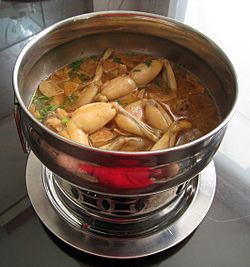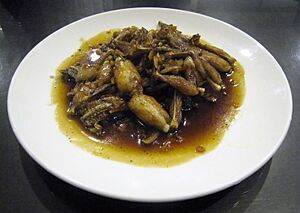Swikee facts for kids

Swikee Kodok Oh, frog legs in tauco soup
|
|
| Course | Main course |
|---|---|
| Place of origin | Indonesia |
| Region or state | Purwodadi in Central Java, and Jatiwangi in West Java |
| Serving temperature | Hot |
| Main ingredients | Frog legs cooked in various sauces |
Swikee is a special dish from Indonesia that uses frog legs. It's a type of Chinese Indonesian food. You can have it as a soup, or with the frog legs fried or stir-fried. This dish started in China but is now very popular in Indonesia.
The name "Swikee" comes from a Chinese language called Hokkien. It means "water chicken." This is a fun way to talk about frogs without saying "frog"! Swikee is often seen as a traditional food from Purwodadi in Central Java and Jatiwangi in Majalengka, West Java.
The main part of swikee is the legs from "green frogs". It's cooked with things like garlic, ginger, and a special fermented soy paste called tauco. Salt and pepper are also added. When it's ready, people often put fried garlic and chopped celery on top. Swikee is usually eaten with plain white steamed rice.
Contents
What Does Swikee Taste Like?
Frog meat tastes a bit like chicken and a bit like fish. Many people say it tastes mostly like chicken because it has a mild flavor. The texture is often compared to chicken wings. Sometimes, it might have a very slight fishy taste.
Usually, only the frog legs are used in the soup because they have the most meat. But sometimes, the frog skin is dried in the sun and then fried to make crispy chips! These salted fried frog skin chips have a unique taste that's different from other chips.
Another way to cook frogs is called "pepes kodok". For this, frog legs and different spices are wrapped in banana leaves. Then, they are cooked over a fire. This gives the frog meat a rich flavor and a special smell from the burned banana leaves.
Where Can You Find Swikee?
Frog dishes are very common in Purwodadi, Grobogan Regency, Central Java. It's a local favorite there! You can also find frog leg dishes in Jatiwangi, Majalengka Regency, West Java.
Big cities in Indonesia like Jakarta, Cirebon, Bandung, Yogyakarta, Semarang, and Surabaya also have swikee. A popular restaurant chain is "Swikee Jatiwangi". Restaurants often use names like "Swikee Purwodadi" or "Swikee Jatiwangi" on their signs.
Indonesia is actually the biggest exporter of frog meat in the world! It sends over 5,000 tons of frog meat each year. Most of it goes to countries like France, Belgium, and Luxembourg. In the past, frogs were caught from the wild, especially when it rained. But now, more and more farms are raising frogs to meet the high demand, especially from France.
Different Kinds of Swikee
Swikee can be served in a soup or stir-fried with different sauces. Here are some popular ways to enjoy it:
- Swikee oh or Kodok oh: Frog legs in a soup made with fermented soybean sauce (tauco).
- Swikee goreng mentega: Stir-fried frog legs cooked with butter or margarine and Worcestershire sauce.
- Swikee kecap: Stir-fried frog legs with sweet soy sauce.
- Swikee saus tomat: Stir-fried frog legs in tomato sauce.
- Swikee asam manis: Fried frog legs with sweet and sour sauce.
- Swikee goreng tepung: Deep-fried frog legs covered in a crispy batter.
- Swikee goreng mayones: Deep-fried battered frog legs served with mayonnaise.
- Pepes swikee: Boneless frog legs seasoned and cooked in a banana leaf, like pepes. There's also pepes telur kodok, which is frog eggs cooked in a banana leaf.
Important Things to Know About Swikee

There are two main things people think about when it comes to eating frog legs in Indonesia: religious beliefs and environmental concerns.
Religious Views
For many people who follow Islam, eating frog meat is considered haraam. This means it's not allowed by their religious laws. There are a couple of reasons for this. Some believe that the meat should not be considered disgusting. Also, some Islamic teachings say that certain animals, like frogs, ants, bees, and some birds, should not be killed by Muslims.
Because of this, there have been discussions about frog legs. For example, in Demak, a city known for being an early Islamic city in Java, officials asked swikee restaurants not to link their food with the city. This was because many people there follow a strict Islamic school that forbids eating frogs.
However, there are different opinions within Islamic law. While some schools of thought, like Safii, Hanafi, and Hanbali, strictly forbid eating frogs, the Maliki school allows certain types of frogs. They say that the green frog often found in rice fields can be eaten. But other types of frogs, especially those with bumpy skin, are seen as poisonous or unclean and should not be eaten.
Environmental Concerns
Environmental groups are worried about how many frogs are being eaten. They especially want to limit eating frogs caught from the wild. This is because frogs are a very important part of the natural world.
In Java, some swikee dishes even use frog eggs, which are often collected from the wild. Experts warn that if too many frogs are caught, their populations could disappear. Frogs, like most amphibians, have thin, moist skin. This makes them very sensitive to changes in their environment and to pollution. The number of amphibians around the world is decreasing. This is due to their homes being destroyed, damage to the environment, and pollution.


